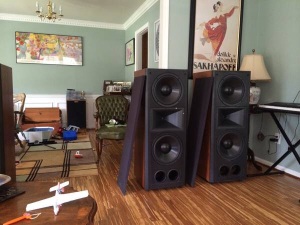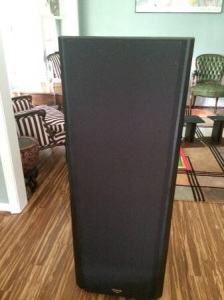Epic – Klipsch CF-4
These came home with me shortly after the Klipschorns and my KG-4s left. The Klipschorns were bigger than life in everything – sound, presence, weight – and even though these are speakers of a lifetime for many, I couldn’t warm to them in the end. They were awesome but required a lot of compromises, at least for me in my space. The KG-4s were harder to part with and after I bid them goodbye I regretted it almost immediately. The KG-4s are really ideal for background listening – their lively horn dynamics and ability to hit hard and low compromise them as critical listening speakers at higher levels but do the opposite at low levels. I’ve replaced them with my restored Polk Monitor 7s which I love but don’t project as much bass.
But then I found the CF-4s. As I started with the Klipschorns I became a lurker on the Klipsch Community forum. Klipsch Community is great – nice folks full of great advice on Klipsch sound systems and many other things. It’s similar to the Polk Forum (which I’ve lauded before) in that aspect. But as much as the Polk folks love to mod their speakers, Klipsch people do too, and they take it even further – replacing components, remodeling horns and tweeter diaphragms, testing new cabinet and speaker reinforcement and damping techniques. Very impressive. But sometimes all of these mods introduce a bit of the ‘Grandpa’s Axe’ paradox – after 5 new handles and a couple new heads, is Grandpa’s axe still the same old tool he’s always had?
CF-4s have a legendary following among Klipsch aficionados. They were envisioned by the legendary Klipsch designer Roy Delgado, who reportedly considered these his favorite design of his career. The legend is that the CF-4, while amazing, strayed too far from the traditional Klipsch Heritage sound, and dealers wouldn’t or didn’t know how to sell them to their clientele. Eventual mods in subsequent model years added sizzle to the tone in a bid to get the dealers back on their side, but high cost (they were almost $4,000 new), expensive components, and low sales numbers led to new models replacing them in 1996, after only 3 model years. CF-4s were the flagship of the Epic line, which also included the CF-3 (dual 10″ two-way, same horn) the CF-2 (8″, different horn) and the CF-1 (6.5″ woofers, 1″ horn)
The CF-4s paired two 12″ neodynium graphite-cone woofers with a massive 2″ aluminum-domed compression driver in an equally-large tractix horn placed between the woofers. The woofers crossed over at 1500hz into the horn. Klipsch reported a Klipschorn-rivalling 102dB @ 1watt/1meter efficiency, which may not be accurate – these things bump on little watts, but not that little.
The three drivers are housed in stately 44″ x 17″ x 19″ cabinets, which are only dwarfed by Klipschorns. They weigh about 60lb apiece, which is surprisingly light for their size. And they come with two port holes at the bottom that are big enough to stuff your fist into.
When I first brought these home they were going right into the spot that the Klipschorns had been. Any my first impression was how much smaller they were than the corner horns. When I plugged them in to my trusty Lepai 2020+ amp I was blown away – other than being smaller than the Klipschorns, these speakers gave up absolutely nothing – CF-4s hit harder and lower and provided a much more even tone across the spectrum – no cut outs in the upper bass area like the Klipschorns. Even with almost no experimentation with placement, imaging was uncanny. I was in love.
These are forever speakers for me. I’m not giving these up. They just do everything too well. Well, that’s not entirely the truth. The fact of the matter is, I picked up two pairs at the same time when I found these – both pairs were made at about the same time in the end of 1994, with both having sequential serial numbers for their pairs. I ended up keeping the pair with the earlier serial numbers and the slightly more-dinged cabinets and I traded the other pair for a Fisher 500C receiver. But that’s when the mysteries began.
Remember how I said that Klipsch changed the CF-4s along the way in their 3-year run? Klipsch devotees refer to these as Series 1, 2, and 3 speakers. Series 1 were made how God and Roy Delgado intended, with a balanced sound, 6″ bass tubes in the ports, and a crossover set up to match. They also had Monster wiring inside. Series 2 got shorter ports to raise the box tuning and efficiency to make them hotter. Series 3 got different woofers of lesser quality and standard small-gauge colored wiring inside the cabinet. This all according to legend. Series 1 speakers are revered, Series 2 less so, and Series 3 denigrated. At least on the forums.
I thought my speakers’ serial numbers placing them in 1994 automatically made them Series 1, Series 2 didn’t start until 1995. But here’s where things get weird. The pair I traded (with the later serial number) has the Monster wire of Series 1 but it has the shorter ports of Series 2. And it’s hard to tell but it may even have the lighter woofers of Series 3 – one of the woofers died and the new owner replaced it with an identical woofer reportedly taken out of a pair of CF-4 Series 3 speakers. My pair has the longer port tubes but has colored internal wiring. And the woofers look the same as in the other pair. Both sets of speakers also have horn material which is a dark color, as opposed to the grey reportedly used on the earliest CF-4s.
People who know CF-4s know all of these little details like it is gospel. Amazing, I know. But that doesn’t explain how my speakers became such a mismatch according to the lore.
So I really don’t have any idea what series speaker I have. And at this point I don’t care. I’ve stopped reading the forum posts which say one pair is better or worse than another. I know that these speakers are something very very special. And when I’m ready there are a host of very cool mods that I can employ to take these to the next level, including cabinet damping, dynamat on horns and baskets, crossovers, and even new (even more humongous) horns. I’ll be ready.
UPDATE: I looked inside the other speaker and it has the clear-coated wiring reportedly used in the Series 1 CF-4s. So now who knows what these are. they still sound great.





Hello
Happy new year.
I am looking a pair of CF4 for sale…
Thank you very much
Beat regards
LikeLike
Would love to chat sometime. Like you I have a pr of Epic CF-4’s and am not certain which Ver I own. According to the serial numbers they are made the begining Mar of 95 05895XXXX. They have have the colored (red & green) internal wire and black horn. Any idea what your crossover values are? Mine do not match the Rev B. I got directly from Klipsch.
LikeLike
I have not looked at my crossovers. I have colored wiring in one, clear-jacketed Monster wiring in the other. My serial numbers place my build date in November 94.
LikeLike
Hello,
I am looking for one pair of CF4 for sale.
Thank you
Beat regards
Grégory
LikeLike
I know you said when you are ready. I hope it’s soon Greg. Jimmy from Jasper. Came across this looking for CF4. I know, you like them!
LikeLike
Thank you Jimmy 🙂
LikeLike
Hi folks, I live in Utah and am looking for a pair of CF-4’s and or a pair of CF-3’s. Would anyone like to sell theirs to me? Please let me know if you do. Thanks,
John
LikeLike
Hello.
I have a pair on hand and the serialnumber is 233597434.
Is that older og newer number than you have in yours?
LikeLike
Those look like newer (likely Series 2) given the serial number and date code – 233rd day of ’95.
LikeLike
Sweet my Cf3s are 213th day of 94…..
LikeLike